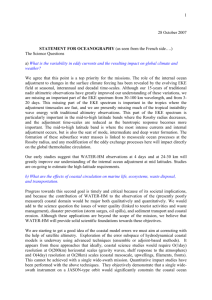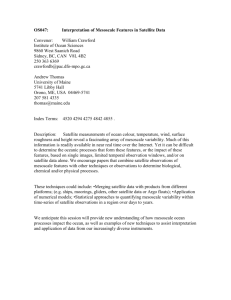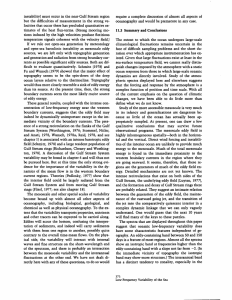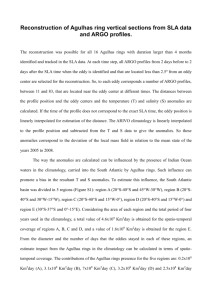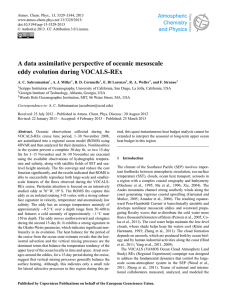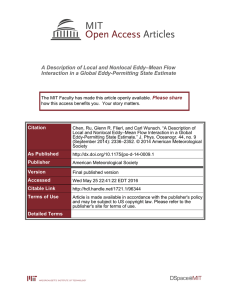MSWord
advertisement
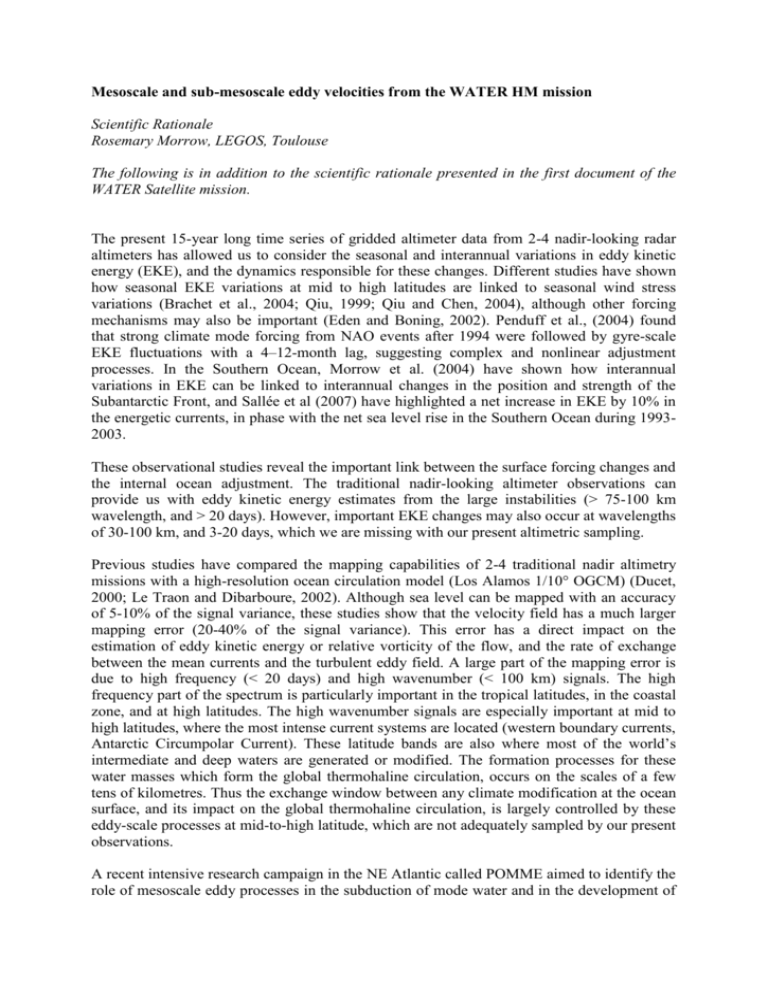
Mesoscale and sub-mesoscale eddy velocities from the WATER HM mission Scientific Rationale Rosemary Morrow, LEGOS, Toulouse The following is in addition to the scientific rationale presented in the first document of the WATER Satellite mission. The present 15-year long time series of gridded altimeter data from 2-4 nadir-looking radar altimeters has allowed us to consider the seasonal and interannual variations in eddy kinetic energy (EKE), and the dynamics responsible for these changes. Different studies have shown how seasonal EKE variations at mid to high latitudes are linked to seasonal wind stress variations (Brachet et al., 2004; Qiu, 1999; Qiu and Chen, 2004), although other forcing mechanisms may also be important (Eden and Boning, 2002). Penduff et al., (2004) found that strong climate mode forcing from NAO events after 1994 were followed by gyre-scale EKE fluctuations with a 4–12-month lag, suggesting complex and nonlinear adjustment processes. In the Southern Ocean, Morrow et al. (2004) have shown how interannual variations in EKE can be linked to interannual changes in the position and strength of the Subantarctic Front, and Sallée et al (2007) have highlighted a net increase in EKE by 10% in the energetic currents, in phase with the net sea level rise in the Southern Ocean during 19932003. These observational studies reveal the important link between the surface forcing changes and the internal ocean adjustment. The traditional nadir-looking altimeter observations can provide us with eddy kinetic energy estimates from the large instabilities (> 75-100 km wavelength, and > 20 days). However, important EKE changes may also occur at wavelengths of 30-100 km, and 3-20 days, which we are missing with our present altimetric sampling. Previous studies have compared the mapping capabilities of 2-4 traditional nadir altimetry missions with a high-resolution ocean circulation model (Los Alamos 1/10° OGCM) (Ducet, 2000; Le Traon and Dibarboure, 2002). Although sea level can be mapped with an accuracy of 5-10% of the signal variance, these studies show that the velocity field has a much larger mapping error (20-40% of the signal variance). This error has a direct impact on the estimation of eddy kinetic energy or relative vorticity of the flow, and the rate of exchange between the mean currents and the turbulent eddy field. A large part of the mapping error is due to high frequency (< 20 days) and high wavenumber (< 100 km) signals. The high frequency part of the spectrum is particularly important in the tropical latitudes, in the coastal zone, and at high latitudes. The high wavenumber signals are especially important at mid to high latitudes, where the most intense current systems are located (western boundary currents, Antarctic Circumpolar Current). These latitude bands are also where most of the world’s intermediate and deep waters are generated or modified. The formation processes for these water masses which form the global thermohaline circulation, occurs on the scales of a few tens of kilometres. Thus the exchange window between any climate modification at the ocean surface, and its impact on the global thermohaline circulation, is largely controlled by these eddy-scale processes at mid-to-high latitude, which are not adequately sampled by our present observations. A recent intensive research campaign in the NE Atlantic called POMME aimed to identify the role of mesoscale eddy processes in the subduction of mode water and in the development of intense spring blooms (JGR Special Issue, 2005). The project was based on an intense in-situ observational campaign, satellite data, and very high resolution regional ocean circulation models. Although the project originally targeted the mesoscale eddy processes, it was found that the smaller-scale filaments (10-30 km) entrained around the mesoscale eddies were most important in the advection of tracers (SST, chlorophyll) and in inducing the largest vertical velocities (exceeding 25 m/day) (Paci et al., 2005; Legal et al, 2007) . Within the filaments, these large vertical velocities bring nutrient-rich deeper layers into the surface euphotic zone, enhancing the spring blooms. The subduction of mode waters was also strongly determined by these filaments, which induced deeper mixed layers, stronger entrainment across the base of the mixed layer, and formed a denser class of mode waters (Paci et al., 2007). These finer-scale processes were revealed with a high resolution regional model (1/20° with 69 vertical levels) and very high resolution in-situ data. However, the position of these filaments, and their spatio-temporal evolution, can also be estimated using lagrangian techniques based on horizontal maps of mesoscale eddy geostrophic currents (eg. Abraham and Bowen 2002; D’Ovidio et al, 2007). Thus we can localise these filaments and the associated regions of intense mixing (~10 km width) using altimetry based velocity maps which have a resolution of > 75-100 km. However, as mentioned before, the present generation of gridded velocity maps from traditional nadir altimeter missions are missing the small period and small wavelength features, especially in mid-to-high latitudes. Finer resolution horizontal velocity maps are needed to better resolve these important features. A recent analysis of a 1/54° resolution OGCM from the Japanese Earth Simulator has been used the determine the minimum space-time scales necessary for the horizontal velocity field, in order to accurately position the lagrangian filaments with respect to SST and chlorophyll tracer fields. Preliminary results at mid latitudes suggest that velocity maps at 4 days and 30 km resolution would be required. On-going studies will determine the requirements in other geographical regions. Abraham, E. R., and M. M. Bowen (2002), Chaotic stirring by a mesoscale surface-ocean flow, Chaos, 12, 373– 381. Brachet S., P. Y. Le Traon, C. Le Provost, 2004. Mesoscale variability from a high-resolution model and from altimeter data in the North Atlantic Ocean, J. Geophys. Res., 109, C12025, doi:10.1029/2004JC002360. d’Ovidio, F., V. Fernandez, E. Hernandez-Garcıa, and C. Lopez (2004), Mixing structures in the Mediterranean Sea from Finite-Size Lyapunov Exponents, Geophys. Res. Lett.,p. 10.1029/2004GL020328. Eden, C., and C. Böning, 2002. Sources of Eddy Kinetic Energy in the Labrador Sea, J. Phys. Oceanogr., 32, 3346-3363. Legal, C., P. Klein, A.-M. Treguier, and J. Paillet (2007), Diagnostics of the vertical motions in a mesoscale stirring region, J. Phys. Oceanogr., in press. Morrow, R.A., A. Brut and A. Chaigneau, 2002. Seasonal and interannual variations of the upper ocean energetics between Tasmania and Antarctica, Deep Sea Res., 50/3, 339 – 356. Paci, A., G. Caniaux, M. Gavart, H. Giordani, M. Le´vy, L. Prieur, and G. Reverdin (2005), A high-resolution simulation of the ocean during the POMME experiment: Simulation results and comparison with observations, J. Geophys. Res., 110, doi:10.1029/2004JC002712. Paci, A., G. Caniaux, H. Giordani, M. Le´vy, L. Prieur, and G. Reverdin (2007), A high-resolution simulation of the ocean during the POMME experiment: Mesoscale variability and near surface processes, J. Geophys. Res., 112, C04007, doi:10.1029/2005JC003389. Penduff, T., B. Barnier, W.K. Dewar, and J.J. O'Brien, 2004. Dynamical response of the oceanic eddy field to the North Atlantic Oscillation: a model-data comparison, J. Phys. Ocean., 34, 2615–2629. Qiu, B. 1999. Seasonal eddy modulation of the North Pacific Subtropical Countercurrent: Topex/Poseidon observations and theory. J. Phys. Oceanogr., 29, 2471-2486. Qiu, B., and S. Chen, 2004: Seasonal modulations in the eddy field of the South Pacific Ocean. J. Phys. Oceanogr., 34, 1515-1527. Sallee, J.B. K. Speer, R.A. Morrow and R. Lumpkin, 2007b. An estimate of Lagrangian eddy statistics and diffusion in the mixed layer of the Southern Ocean. J. Mar. Res. (submitted)
